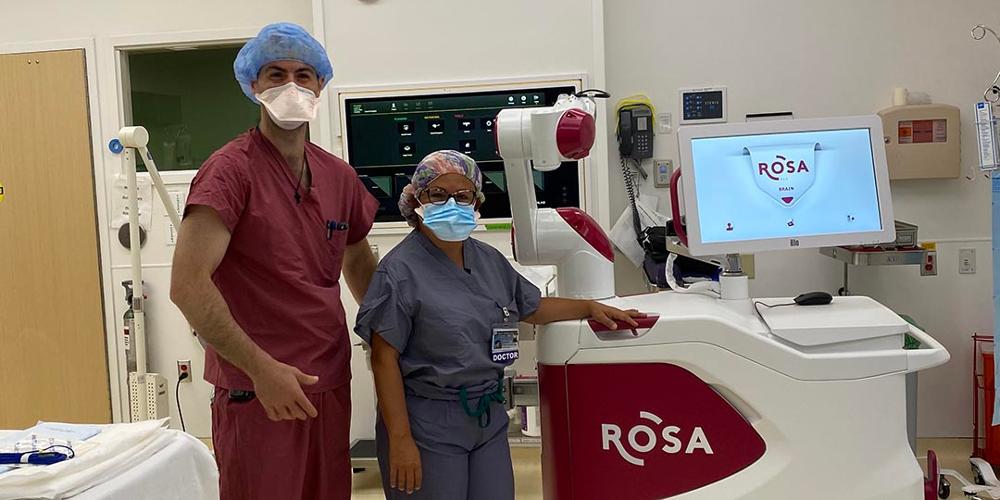Upstate first hospital in CNY to use ROSA Brain robot for minimally invasive brain surgery
Upstate University Hospital has started using a new robot technology to perform minimally invasive brain surgery that offers a higher level of accuracy and in many cases reduces procedure time by several hours.
The ROSA Brain robot is a surgical navigation and positioning system that allows surgeons at Upstate to perform procedures more accurately, with fewer complications and sometimes in half the time as before. The ROSA Brain robot has so far been used at Upstate for a pediatric laser ablation and for a procedure to treat epilepsy in an adult. ROSA stands for robotic surgical assistant.
Gaddum Reddy, MD, is director of Adult Functional Neurosurgery at Upstate and specializes in epilepsy and epilepsy surgery. Reddy described what’s called an invasive monitoring procedure he performs to identify the source of seizures in epileptic patients. Originally, the procedure was completed with a craniotomy, which involves removing a piece of skull bone. That procedure has since evolved to drilling tiny holes in the skull to place depth electrodes in the brain. Reddy said using that method, he could place 10 electrodes in about six hours.
In a recent, similar procedure using the ROSA Brain robot, Reddy said he was able to place 18 electrodes in just four hours.
“I was basically able to place twice as many electrodes in half the time,” he said. His ability to place more electrodes gives him a better chance of identifying where the seizures are coming from. Reddy said the ROSA robot allows him to map placement of the electrodes with greater speed and precision.
“The biggest benefit of the robot is twofold. It speeds up the process so rather than me having to manually put in these numbers (to map electrode placement), I put them all into the computer that’s attached to the robot and the robot goes from one point to the next point very quickly,” Reddy said. “There’s a lot of chance for error when I’m putting those points in. Using the robot, the accuracy was as good if not better and the risk of mistake was significantly lower because the machine takes care of all of the numbers.”
Zulma Tovar Spinoza, MD, is director of Pediatric Neurosurgery, director of Pediatric Epilepsy Surgery of Neurosurgery and director of the Laser Ablation Program of Neurosurgery at Upstate. She, too, is using the ROSA Brain robot, most recently in a successful pediatric laser ablation surgery. “Everything went exceptionally well,” she said of that procedure using the ROSA Brain robot.
Reddy and Tovar Spinoza both said they anticipate using the ROSA robot for most if not all future laser ablations and depth electrode placement procedures.
Upstate is the only hospital in Central New York using the ROSA Brain robot, which is housed at the downtown campus and created by device manufacturer Zimmer Biomet. The robot can also be used in deep brain stimulation, trans-nasal and ventricular endoscopy and brain biopsies.
“The robot puts us on the vanguard of being at the level of institutions with the highest standards around the world,” Tovar Spinoza said.
Reddy said this new method and technology decreases the risk of infection, hemorrhage and wound healing. “This allows Upstate to treat our patients more effectively, faster and more accurately with less chance of complications,” Reddy said.
Upstate’s Epilepsy Program has received the highest accreditation as a Level 4 comprehensive program that serves adults and children. For more information visit www.upstate.edu/neurology/healthcare/clinics/epilepsy.php.
Caption: Zulma Tovar Spinoza, MD, (right) is director of Pediatric Neurosurgery, director of Pediatric Epilepsy Surgery of Neurosurgery and director of the Laser Ablation Program of Neurosurgery at Upstate. She stands next to the new ROSA Brain robot in an Upstate operating room with neurosurgery resident George Koutsouras, MD.

